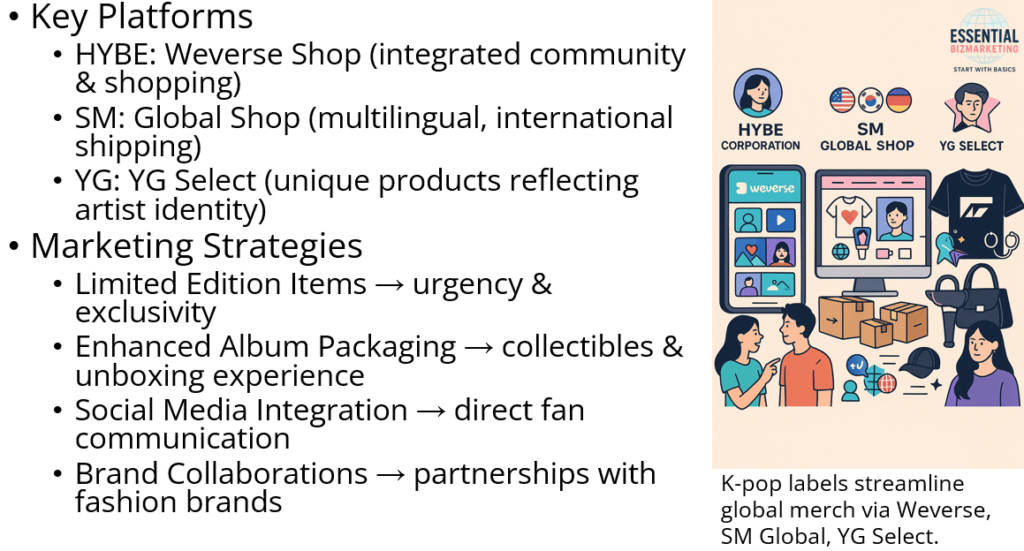Introduction to K-pop Merchandise and Fandom Culture

The global rise of K-pop has not only spotlighted its music and performances but also emphasized the significance of merchandise in fostering a deeper connection between artists and their fans. Official merchandise serves as a tangible link, allowing fans to express their support and feel a closer bond with their favorite artists. This dynamic has led entertainment companies to develop sophisticated strategies to cater to the diverse and widespread K-pop fandom.
Evolution of Merchandise Platforms
To meet the growing demand for official goods, major K-pop entertainment companies have established dedicated merchandise platforms. For instance, HYBE Corporation operates Weverse Shop, which integrates with the Weverse community platform, enabling fans to purchase official merchandise, albums, and exclusive content directly. This seamless integration enhances the fan experience by combining community engagement with shopping convenience. Similarly, SM Entertainment manages SM Global Shop, offering a wide array of products related to its artists. By providing international shipping and multilingual support, SM Global Shop ensures that fans worldwide can access and purchase official merchandise effortlessly. YG Entertainment runs YG Select, providing fans with official goods ranging from apparel to accessories. The platform emphasizes unique and high-quality products that reflect the distinct identity of YG’s artists, catering to both domestic and international markets.
Strategic Marketing Approaches
K-pop companies employ several strategic approaches to maximize merchandise sales globally. Releasing limited edition items creates a sense of urgency and exclusivity, encouraging fans to make prompt purchases. This strategy not only boosts sales but also enhances the perceived value of the merchandise. Additionally, K-pop albums often include a variety of collectibles such as photobooks, photocards, and posters. This curated unboxing experience transforms a simple purchase into an event, increasing fan satisfaction and encouraging repeat purchases. Leveraging social media and dedicated apps, companies announce new merchandise releases, special promotions, and restocks. This direct communication keeps fans informed and engaged, fostering a sense of community and anticipation. Furthermore, partnering with fashion brands and designers elevates the merchandise’s appeal. For instance, collaborations between K-pop idols and luxury brands have resulted in unique product lines that attract both fans and fashion enthusiasts.
Global Accessibility and Fan Engagement

Ensuring global accessibility is paramount in K-pop merchandise marketing. Companies invest in international shipping solutions, multilingual customer service, and regional warehouses to expedite delivery times. Additionally, fan engagement initiatives such as online fan meetings, exclusive content releases, and interactive events enhance the overall experience, strengthening the bond between artists and their international fanbase.
Conclusion
The success of K-pop merchandise in the global market is a testament to the industry’s innovative marketing strategies and deep understanding of fan culture. By creating exclusive, high-quality products and ensuring worldwide accessibility, K-pop companies have transformed merchandise into a vital component of the fan experience, further solidifying the global presence of K-pop.
📚 References
HYBE Corporation. (n.d.). Weverse Shop. Retrieved March 29, 2025, from https://weverseshop.io/
SM Entertainment. (n.d.). SM Global Shop. Retrieved March 29, 2025, from https://smglobalshop.com/
YG Entertainment. (n.d.). YG Select. Retrieved March 29, 2025, from https://ygselect.com/
Chen, Z. (2024, July 9). Inside culture: What brands can learn from K-pop marketing about how to create cultural capital. WARC. Retrieved March 29, 2025, from https://www.warc.com/newsandopinion/opinion/inside-culture-what-brands-can-learn-from-k-pop-marketing-about-how-to-create-cultural-capital/en-gb/6724
Chung, D. (2022, August 8). Building an ‘ARMY’ of Fans: Marketing Lessons from K-Pop Sensation BTS. Harvard Business School Working Knowledge. Retrieved March 29, 2025, from https://www.library.hbs.edu/working-knowledge/building-an-army-of-fans-marketing-lessons-from-kpop-sensation-bts
“Cultural impact of BTS.” (n.d.). Wikipedia. Retrieved March 29, 2025, from https://en.wikipedia.org/wiki/Cultural_impact_of_BTS
“SM Brand Marketing.” (n.d.). Wikipedia. Retrieved March 29, 2025, from https://en.wikipedia.org/wiki/SM_Brand_Marketing
“Fandom culture in South Korea.” (n.d.). Wikipedia. Retrieved March 29, 2025, from https://en.wikipedia.org/wiki/Fandom_culture_in_South_Korea
📁 Start exploring the Blog
📘 Or learn more About this site
🧵 Or follow along on X (Twitter)
🔎 Looking for sharp perspectives on global trade and markets?
I recommend @GONOGO_Korea as a resource I trust and regularly learn from.
